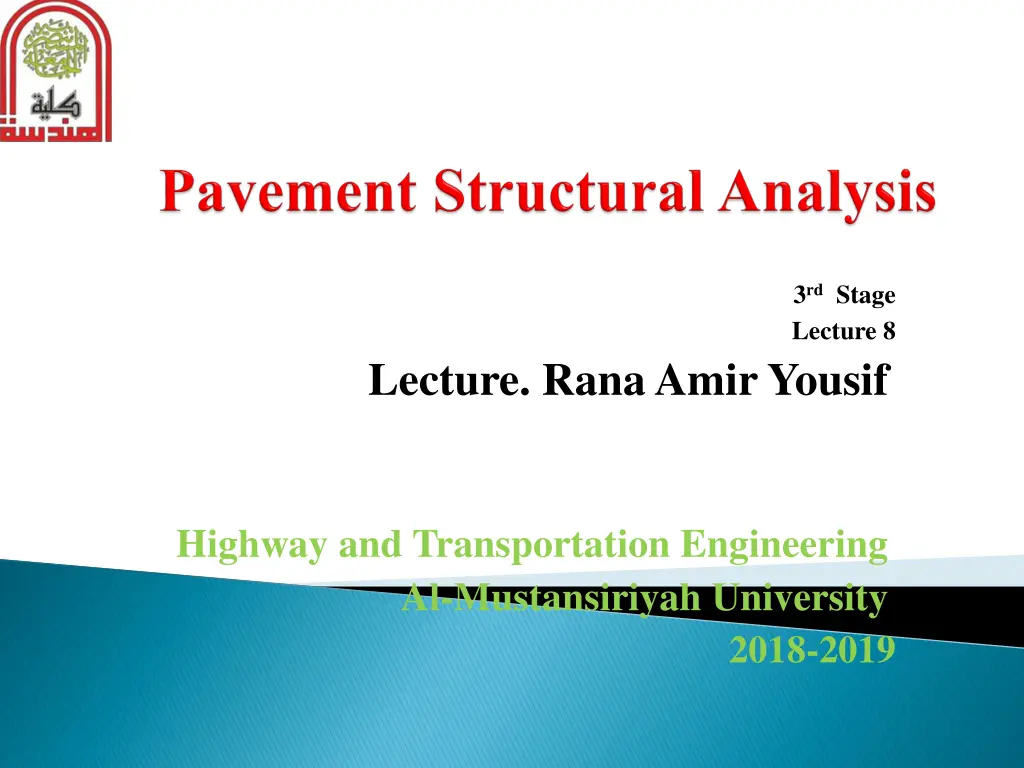
Understanding Stresses in Rigid Pavements Due to Vehicle Loading
Learn how stresses in rigid pavements are generated by vehicle loads, temperature changes, and other factors. Explore Westergaard's formulas for analyzing stress distribution in concrete slabs under different loading conditions.
Download Presentation

Please find below an Image/Link to download the presentation.
The content on the website is provided AS IS for your information and personal use only. It may not be sold, licensed, or shared on other websites without obtaining consent from the author. If you encounter any issues during the download, it is possible that the publisher has removed the file from their server.
You are allowed to download the files provided on this website for personal or commercial use, subject to the condition that they are used lawfully. All files are the property of their respective owners.
The content on the website is provided AS IS for your information and personal use only. It may not be sold, licensed, or shared on other websites without obtaining consent from the author.
E N D
Presentation Transcript
3rdStage Lecture 8 Lecture. Rana Amir Yousif Highway and Transportation Engineering Al-Mustansiriyah University 2018-2019
References: Nicholas J. Garber and Lester A. Hoel. Traffic and Highway Engineering , Fourth Edition. Yoder; E. J. and M. W. Witczak, Principles of Pavement Design , A Wiley- Interscience Publication, John Wiley & Sons Inc., U.S.A., 1975. Yaug H. Huang, Pavement Analysis and Design , Prentic Hall Inc., U.S.A., 1993. AASHTO Guide for Design of Pavement Structures 1993 , AASHTO, American Association of State Highway and Transportation Officials, U.S.A., 1993. Oglesby Clarkson H., Highway Engineering , John Wiley & Sons Inc., U.S.A., 1975.
Stresses in rigid pavements result from variety of sources, of which the applied vehicle loads, changes in temperature of the slab, friction between the slab and the subgrade or base course are the most important. These factors tend to result in deformations of the concrete slab, which cause tensile, compression, and flexural stresses of varying magnitude. 2.2.1. Stresses Due to Vehicle Loading Three methods can generally be used to determine the stresses and deflections in concrete pavements due to vehicle loading: 1. Westergaard s formulas 2. Influence charts 3. Finite element analysis
Here, Westergaards formulas derived to examine three critical conditions of loading: corner loading, interior loading, and edge loading far from any corner are described. Westergaard s assumptions: The concrete slab acts as a homogenous isotropic, elastic solid in equilibrium. The reactions of the subgrade are vertical only and they are proportional to the deflections of the slab. The thickness of the concrete slab is uniform. The load at the interior and the corner is distributed uniformly over a circular area of contact and the circumference of the contact area at the corner is tangent to the edges of the slab. The edge loading is distributed uniformly over a semi-circular area, the diameter of the semi-circle being at the edge of the slab.
Corner Loading: when a circular load is applied near the corner of the concrete slab, the stress, c, and the deflection, c, at the corner are given by in which P is the load, l is the radius of relative stiffness defined as , k is the modulus of the subgrade reaction, and a is the contact radius. The results obtained applying the finite element method of analysis are:
where, c is the side length of the a square contact area, c = 1.772a Modulus of subgrade reaction, k, is the constant that defines the subgrade in classical works of rigid pavements as shown in Figure 2-14 and defined as: where, p is the reactive pressure, and is the deflection of the slab. The value of k is determined by means of the plate-loading tests.
Figure 2-14: (a) Definition of subgrade reaction, k, (b) plot of plate loading test to determine subgrade reaction
Interior Loading: The formula developed by Westergaard for the stress in the interior of a slab under a circular loaded area of radius a is in which l is the radius of relative stiffness and The deflection due to interior loading is
Edge Loading: The stresses and deflections due to edge loading as formulated by Westergaard are: For circular contact area For semicircular contact area
When a load is applied over a set of dual tyres, the equations can be used after converting the contact area of the dual tyres into a radius, a, of equivalent circular contact area as: where, Pd is the load on dual tyres, q is the contact pressure, Sd is the spacing of the tyres.






















